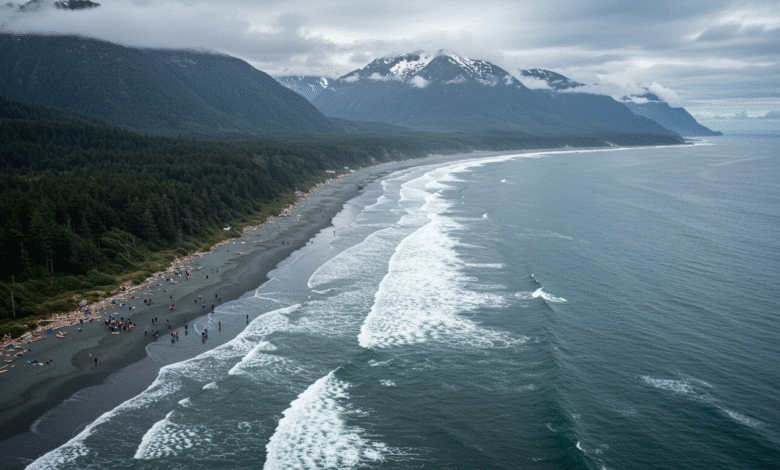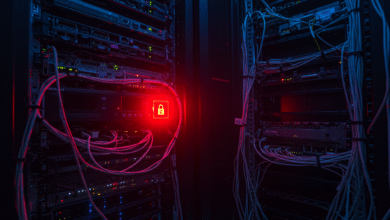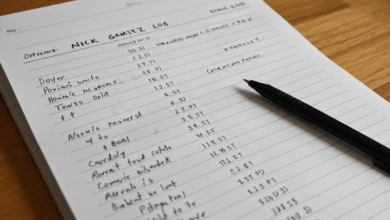Understanding the Alaska Tsunami Warning

What Is a Tsunami Warning?
A tsunami warning is a public alert that notifies residents of coastal regions about a potential large ocean wave triggered by an underwater or coastal seismic event. In Alaska—one of the most seismically active places in the world—such warnings are critical.You know about theglobespot, andaazdaily, openrendz and alaska tsunami warning also Buzzfeed.
Why Does Alaska Face High Tsunami Risk?
-
Tectonic hot spot: Alaska sits along the boundary of the Pacific and North American tectonic plates.
-
Frequent earthquakes: Movements along the Alaska-Aleutian subduction zone trigger powerful quakes.
-
Vast coastline: Thousands of miles of coast mean many communities are vulnerable.
-
Historical precedent: The 1964 Great Alaska Earthquake and tsunami remain the most powerful recorded in North American history.
Seismic Activity in Alaska
The Alaska-Aleutian Subduction Zone
Along the Aleutians, the Pacific Plate dives beneath North America. That subduction builds stress—then releases it suddenly in large earthquakes. Furthermore, underwater landslides triggered by these quakes can generate tsunamis.
Major Earthquake Events
-
1964 Great Alaska Earthquake (9.2 magnitude):
It unleashed tsunami waves that hit Alaska and reached the Pacific Northwest, leading to significant loss of life and property. -
Kodiak Island tsunamis: Experience repeated tsunami waves following offshore quakes.
-
Recent quakes: On occasion, smaller (~6–7 magnitude) temblors still prompt community-level alerts.
The Science Behind Tsunamis
What Triggers a Tsunami?
-
Underwater earthquakes: The most common cause.
-
Landslides: Caused by quakes or volcanic activity.
-
Volcanic eruptions: Sudden collapse of a volcano can displace massive water volumes.
-
Glacial calving: Icefall into water bodies sometimes causes local waves, though usually smaller.
In Alaska, the first two dominate.
How Tsunamis Travel
Tsunamis travel across open ocean at great speeds—up to 500–600 mph. However, in deep water their wave height stays low, sometimes just a few feet. As they approach shallower coastal areas, wave speed decreases and height increases dramatically, posing serious danger to shorelines.
Tsunami Detection and Monitoring
Seismic Networks
The Alaska Earthquake Center and the National Tsunami Warning Center (NTWC) continuously monitor seismic activity. They detect underwater quakes and quickly assess the likelihood of a tsunami.
Sea-Level and Buoy Sensors
In addition to seismic data, a network of buoys and tide gauges monitors sea-level changes. Sudden changes can indicate a tsunami wave is forming.
NOAA’s Warning System
When data indicate a serious tsunami threat, the National Oceanic and Atmospheric Administration (NOAA) issues bulletins to local authorities and media. These warnings spread through emergency alert systems, sirens, and apps.
Types of Tsunami Alerts
1. Tsunami Watch
This alert warns of potential tsunami conditions. Coastal residents should stay informed, but no immediate action is usually required.
2. Tsunami Advisory
A tsunami is likely, with strong hazards such as strong currents and elevated water levels. Beach-goers should avoid the water, and mariners must secure vessels.
3. Tsunami Warning
A tsunami with significant waves is imminent. Residents in evacuation zones must move to higher ground or pre-designated safety areas without delay.
4. Tsunami Threat Reduction Message
A more recent category from NOAA clarifies possible threats while further data is collected. It helps reduce confusion in early stages of warning.
The 1964 Great Alaska Earthquake and Tsunami
A Historic Catastrophe
On March 27, 1964, a 9.2 magnitude earthquake struck near Prince William Sound. This quake remains the second-largest ever recorded, and it spawned a tsunami that reached heights of over 100 feet in some coastal communities.
Human and Environmental Toll
-
Over 130 people died in Alaska and another 12–16 along the West Coast.
-
Coastal towns—including Valdez and Seward—suffered extensive destruction.
-
Entire communities drowned or were forced to relocate.
Lessons Learned
This event prompted Alaska (and the U.S.) to bolster tsunami detection, warning systems, evacuation routes, signage, and public education programs. It also led to the creation of NOAA’s dedicated tsunami warning infrastructure.
Current Alert System in Alaska
National Tsunami Warning Center (NTWC)
Headquartered in Palmer, Alaska, the NTWC monitors seismic activity across Alaska and the Pacific. They provide real-time alerts to federal, state, and local authorities.
Community Preparedness
-
Evacuation zones: Clearly marked signed routes guide residents to safety.
-
Sirens and outdoor speakers: Installed in tsunami-prone coastal communities.
-
Education programs: Schools and civic groups regularly practice drills.
-
Apps and SMS alerts: Platforms like Wireless Emergency Alerts and the FEMA app disseminate notifications.
Coordination
State agencies, such as Alaska Division of Emergency Services, coordinate with NOAA, the U.S. Geological Survey (USGS), and local governments to execute rapid response plans.
How Alaskans Prepare and React
First Steps During a Warning
-
Stop and listen: Sirens sound and alerts arrive on devices.
-
Immediate evacuation: Fast move to high ground (100 ft above sea level recommended).
-
Avoid roads: Minimize traffic congestion by using footpaths if safe.
-
Stay away from water: Waves, currents, and debris make the coast extremely dangerous.
Emergency Kits
Alaskans maintain grab-and-go kits with:
-
Water and non-perishable food (3-day supply).
-
First-aid supplies and medications.
-
Flashlight, batteries, and radio.
-
Important documents sealed in waterproof packaging.
Community Resilience
-
Community centers: Doubled as safe zones where supplies are stockpiled.
-
Local drills: Regularly conducted to reinforce readiness.
-
Volunteer response teams: Trained in search, rescue, and communications.
Real-Time Tsunami Warning Workflow
-
Seismic event occurs and automatic sensors signal NTWC.
-
Rapid analysis confirms quake size, depth, and ocean impact potential.
-
Sea-level sensors verify abnormal fluctuations.
-
Warning issued across emergency channels.
-
Evacuation protocols activated via sirens, texts, email, and social media.
-
Response teams mobilize to assist and monitor conditions.
-
Updates and cancellation messages follow based on wave activity and data.
Case Studies: Recent Alerts in Alaska
2020 Simeonof Island Quake
-
A 7.8 magnitude quake rocked southwestern Alaska.
-
NTWC quickly issued a tsunami warning; coastal towns evacuated.
-
The threat passed as wave height stayed under 3 feet, and the warning was lifted safe and timely.
2018 Shumagin Islands Event
-
A magnitude 7.9 quake prompted advisories across the Gulf of Alaska.
-
Waves hit Kodiak at about 2.5 feet—no major damage, but residents remained cautious until the advisory was lifted.
Role of Tech and Innovation
Deep‑ocean Assessment and Reporting of Tsunamis (DART)
These buoys use pressure sensors on the seafloor to detect tsunami waves in open ocean—then transmit real-time data to warning centers.
Earthquake Early Warning Systems
This network notifies people seconds to minutes before shaking arrives. Though not tsunami-specific, it gives coast residents valuable seconds to begin evacuation.
Satellite Communication
Satellites broadcast alerts, while internet platforms push critical information even in remote areas with limited infrastructure.
Mobile Notification Apps
Apps like FEMA, ShakeAlert, and MyStateAlerts allow users to subscribe to tsunami and earthquake alerts relevant to their locations.
Challenges and Opportunities
Gaps in Sensor Coverage
Some remote Alaska areas still lack sensors or buoys, meaning tsunami detection depends only on seismic data and sea-level gauges.
Public Fatigue
Frequent advisories can cause complacency. Continuous public education and drills help maintain awareness.
Remote Evacuations
Isolated villages face unique challenges: limited roads, unpredictable weather, and fewer communication tools.
Investment Needs
Ongoing funding for technology upgrades, sensor deployment, and local infrastructure is vital.
Tips for Coastal Visitors
If you’re visiting Alaska’s coastal areas:
-
Learn evacuation zones and safe routes in any small town.
-
Pay attention to posted signs near beaches and harbors.
-
Bring a battery-powered radio or always keep your phone charged.
-
Sign up for local alerts before travel.
-
Know the difference between “advisory” and “warning”—both matter, but one demands immediate action.
Comparing Alaska’s System With Others
West Coast U.S.
California, Oregon, and Washington share NOAA’s infrastructure, but Alaska’s system emphasizes remote monitoring and localized evacuation procedures due to its unique geography.
International Programs
-
Japan: Extremely advanced with densely deployed sensors and mobile alerts.
-
Chile: Strong sensor network but relies heavily on tsunami evacuation towers in remote zones.
Alaska continues to learn from these nations’ experience and invests in similar infrastructure.
Climate Change Impacts
Rising Sea Levels
Higher sea levels mean even moderate tsunamis may extend further inland.
Changing Coastlines
Erosion and thawing permafrost reshape coastlines, affecting evacuation route reliability.
More Rain, Less Ice
Abundant rain can trigger landslides—potential tsunami triggers—while reduced sea ice leads to new coastal erosion.
However, Alaska has research initiatives focused on modeling how these climate changes might affect tsunami risk.
Tsunami Education and Outreach
School Programs
Alaska public schools regularly incorporate tsunami safety into curriculum, including evacuation drills and earthquake preparedness.
Public Campaigns
Siren drills and community fairs help spread tsunami awareness and preparedness tips.
Media Collaboration
Local media outlets broadcast educational segments and public service announcements, especially during National Tsunami Preparedness Week.
If You Observe Unusual Natural Signs
A tsunami warning might not even be issued in time, so awareness of natural warning signs is key:
-
Strong ground shaking, lasting 20 seconds or more—evacuate without delay.
-
Sudden sea level change, either retreating far beyond the usual shoreline or a rapid surge.
-
Roaring ocean sound, louder or different than normal surf.
In such cases, continue moving inland even if no alert arrives immediately.
Staying Informed During an Event
-
Emergency apps: Sign up in advance.
-
NOAA Weather Radio: Offers continuous updates even during outages.
-
Local alerts: Sirens and public loudspeakers have the latest.
-
News outlets & social media: Provide real-time updates but verify official sources.
Recovering After the Tsunami Risk Passes
When to Return
Only re-enter zones when authorities officially declare them safe. They assess water level stability, structural safety, and contamination first.
Cleanup and Health
-
Wear protective gear while cleaning.
-
Avoid compromised water until services return.
-
Report hazards to emergency services promptly.
Mental Health Support
Stress and loss can take a toll. Counseling and support from community and government programs are essential.
Future Directions
Expanding Sensor Networks
Placing sensors near fracture zones and remote shorelines remains a priority.
Community Resilience Hubs
Multi-use centers with pre‑positioned emergency supplies can support communities better.
Enhanced Mobile Alerts
Geo-fenced alerts and social-media-enabled updates are improving notification speed and accuracy.
Scientific Research
Alaska’s scientists model underwater landslides, coastal erosion, and quake‑tsunami dynamics to better predict tsunami behavior.
Summary: What Matters Most
-
Alaska has high tsunami risk due to its seismic setting and coastline.
-
A robust mix of seismic monitoring, sensors, and alerts minimizes threats.
-
The 1964 event shaped national systems and infrastructure.
-
Prepared communities, clear evacuation routes, and regular drills save lives.
-
Technological innovations—DART buoys, early‑warning systems, satellite alerts—enhance response.
-
Individual preparedness, awareness of natural warnings, and updated info sources are key.
Final Thoughts
Tsunami warnings in Alaska are more than alerts—they’re a vital shield for coastal communities and visitors alike. With active planning, education, and technology, Alaska continues to strengthen its resilience against nature’s most powerful waves.



